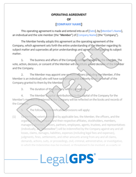Professional Services Agreements: Unlocking the Basics for Your Business
When it comes to the business world, nothing can quite replicate the satisfaction of a successful collaboration. However, success doesn’t just...
Navigating the world of vendor agreements can be challenging, but don't worry. In this guide, we're going to make it simple and approachable for everyday entrepreneurs like you. After reading this, you'll have a firm grasp on what a vendor agreement is, why it’s essential, and how to write one.


Get Your Vendor Agreement Today!
Legal GPS templates are drafted by top startup attorneys and are fully customizable🛠️.
Trusted by 1000+ businesses to close secure deals.
A vendor agreement, in simple terms, is a legally binding contract between your business and a supplier, service provider, or other external parties that sell goods or services to your company. The primary purpose of a vendor agreement is to set out the terms and conditions under which they will deliver their goods or services to you.
These terms can include payment terms, delivery schedules, quality standards, and other essential details. By establishing these conditions upfront, you can create a clear understanding between both parties, avoid potential misunderstandings, and protect your business interests in the long run.
You may be wondering, "Why do I need a vendor agreement? Can't we operate on good faith and trust?" While trust is essential in any business relationship, the reality is that disputes can arise in even the best of partnerships. That's where a vendor agreement comes in handy.
Here are a few reasons why your business needs a vendor agreement:
1. Clarity in terms and expectations: A well-drafted vendor agreement will outline the terms and conditions, roles, and responsibilities of each party. This clarity can help minimize the risk of misunderstandings or misinterpretations down the line.
2. Protection of your business interests: A vendor agreement can include clauses that safeguard your business from potential risks and losses. For example, a confidentiality clause can protect your sensitive information from being disclosed to external parties.
3. Legal compliance: As a business owner, you're responsible for ensuring that your business operations comply with all relevant laws and regulations. A vendor agreement can include provisions that require the vendor to meet compliance obligations.
4. Dispute resolution: In the unfortunate event of a dispute, a vendor agreement outlines the methods for addressing conflicts and provides a framework for resolving disagreements amicably.
Now that we've talked about why vendor agreements are vital, let's take a closer look at the key components that should be included in your agreement:
1. Scope of services: Clearly state the services or goods being provided by the vendor and any specific requirements, such as quality standards or delivery deadlines.
2. Contract duration: Specify the timeframe during which the agreement is effective, along with any renewal options.
3. Payment terms: Detail how and when the vendor will be paid, including deposit amounts, due dates, and whether there are any penalties for late payments.
4. Intellectual property rights: Establish who owns any intellectual property (IP) generated during the relationship, such as copyrights, patents, and trademarks.
5. Confidentiality: If the vendor will have access to sensitive business information, include a clause requiring them to maintain confidentiality.
6. Termination: Define the terms under which the agreement can be terminated, including any notice periods and potential penalties.
7. Liability and indemnification: Outline each party's responsibility for damages, losses, or claims arising from their actions during the agreement, and establish any indemnification requirements.
8. Dispute resolution: Specify the methods to resolve disputes – such as mediation, arbitration, or litigation.
9. Governing law: Indicate the jurisdiction whose laws will govern the contract and any disputes arising from it.
10. Miscellaneous provisions: Include any other clauses relevant to your agreement, such as force majeure clauses, insurance requirements, or subcontracting regulations.
Now that you have a general understanding of what should be included in a vendor agreement, let's take a closer look at how to write one:
Before diving into writing the agreement, collect essential details about your business relationship with the vendor, including:
Contact information for both parties
A description of the products or services being provided
Project timelines or delivery schedules
Payment terms and billing information
Any other specific requirements or expectations
This information will help you build a comprehensive agreement that addresses all aspects of the relationship.


Legal GPS Pro
Protect your business with our complete legal subscription service, designed by top startup attorneys.
While drafting from scratch is always an option, using a vetted contract template as a starting point can save you time and effort. Select a template that covers the key elements relevant to your vendor relationship, keeping in mind that you'll be customizing it to fit your specific needs.
Organize your vendor agreement into sections that cover the following topics:
Title and preamble: Begin with a title that describes the purpose of the agreement (e.g., "Vendor Agreement" or "Product Supply Agreement") and a brief introductory paragraph that identifies the parties involved and the agreement's effective date.
Definitions: Define any terms used throughout the agreement that may need clarification, such as "vendor," "products/services," "intellectual property," and "confidential information."
Body of the agreement: Include separate sections for each key component of the agreement we covered earlier, such as scope of services, contract duration, payment terms, intellectual property rights, confidentiality, termination, liability, dispute resolution, and governing law. Adjust the heading names as needed, based on your specific contract terms.
Signatures: Conclude the agreement with a space for both parties to sign and date the document.
Get Your Vendor Agreement Template
with a Legal GPS Subscription
Now it's time to dive into the content of your vendor agreement. Carefully review each section of your selected template, adapting it to match the specific details you gathered in Step 1. Keep the language clear, concise, and approachable, while ensuring that each clause adequately addresses your requirements and desired outcomes.
Remember that your vendor agreement is a reflection of your business relationship, so don't be afraid to fine-tune the wording or add/delete sections to make it work for you.
Once you've completed the customization process, double-check the entire document for any inconsistencies or errors. Ensure that each section is clear and aligns with the overall goals of the agreement. You might want to consider asking a trusted colleague or legal professional to review the document as well, as they may catch potential issues you may have missed.
Now that your vendor agreement is complete, present it to the vendor for their review and input. Encourage open communication, feedback, and negotiation to ensure the agreement is mutually beneficial and acceptable to both parties.
After both parties have reached an agreement on the terms, make any necessary revisions, and ensure that the final document aligns with both parties' expectations. Sign and date the agreement in the presence of a witness (if needed), and provide copies for both parties to retain.

Get Your Vendor Agreement Today!
Legal GPS templates are drafted by top startup attorneys and are fully customizable🛠️.
Trusted by 1000+ businesses to close secure deals.
You might be wondering how to save time and potentially avoid legal fees when creating a vendor agreement. That's where contract templates come in handy:
1. Ease of use: Contract templates are designed to be user-friendly, allowing you to quickly and easily customize them to fit your unique situation.
2. Comprehensive coverage: Professionally developed templates should address all essential elements of a vendor agreement and can provide peace of mind knowing they have covered all the bases.
3. Cost-effective: Using an attorney-prepared contract template can save you time and money when compared to having a lawyer draft your agreement from scratch.
4. Consistent format: Using a template can help to maintain consistency across all your vendor agreements, making them easier to manage and review.
Our contract templates at Legal GPS are designed to deliver just that! Developed by experienced legal professionals, they provide a cost-effective and reliable starting point for drafting your vendor agreement.
Understanding and creating vendor agreements is an essential skill for every entrepreneur. With this guide, you should now be better prepared to handle this critical aspect of your business.
Remember, while vendor agreements can be written independently, using a vetted contract template or consulting with a legal professional can help ensure that your interests are well-protected. We offer a wide range of attorney-approved contract templates, making it easier than ever to secure the right vendor agreement for your business.
Don't leave it to chance – take control of your business relationships with a vendor agreement today!
The biggest question now is, "Do I need a business lawyer?” For most businesses and in most cases, you don't need a lawyer to start your business. Instead, many business owners rely on Legal GPS Pro to help with legal issues.
Legal GPS Pro is your All-In-One Legal Toolkit for Businesses. Developed by top startup attorneys, Pro gives you access to 100+ expertly crafted templates including operating agreements, NDAs, and service agreements, and an interactive platform. All designed to protect your company and set it up for lasting success.
Get Legal GPS's Vendor Agreement Template Now

Legal GPS Pro
Protect your business with our complete legal subscription service, designed by top startup attorneys.
| Premium Template Single-use Template |
Legal GPS Pro Unlimited Access, Best Value |
|
|
| Get Template | Learn More |
| Trusted by 1000+ businesses | |

When it comes to the business world, nothing can quite replicate the satisfaction of a successful collaboration. However, success doesn’t just...

When running a business, there's a good chance you'll need to enter into contracts with service providers, contractors, or consultants. In these...

You've decided to use your knowledge and passion to help others as a coach. That's awesome! But to make sure your coaching relationship works as...